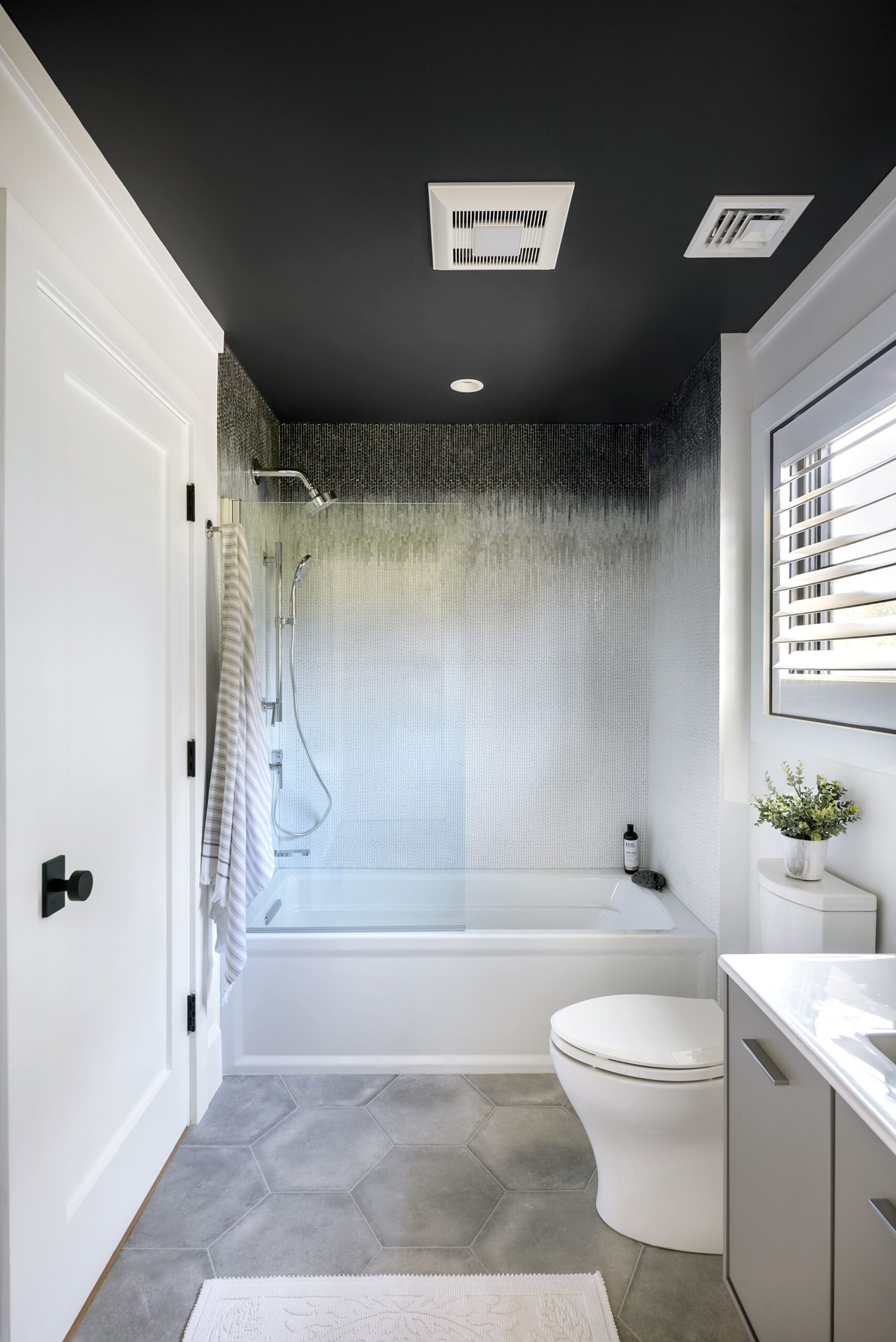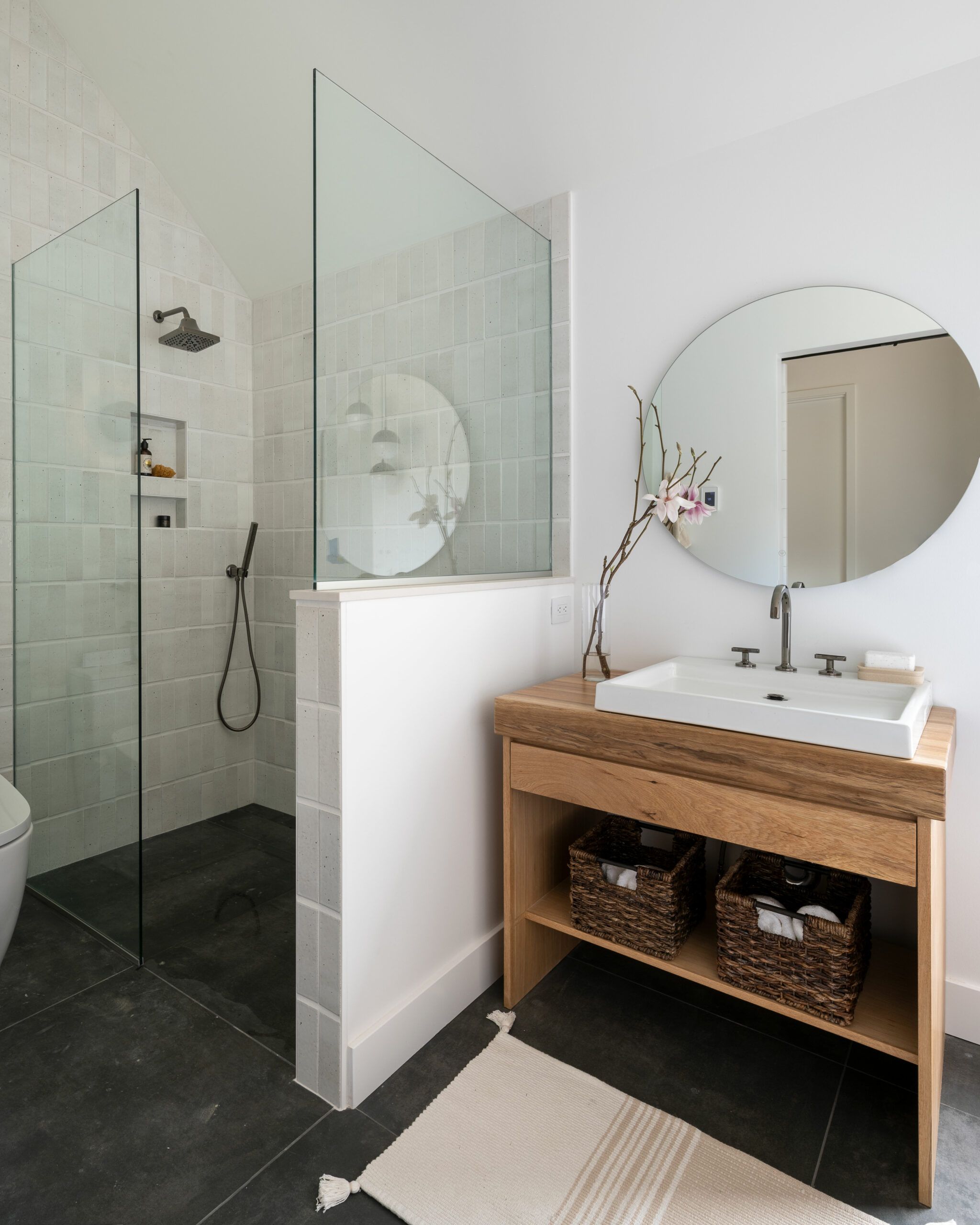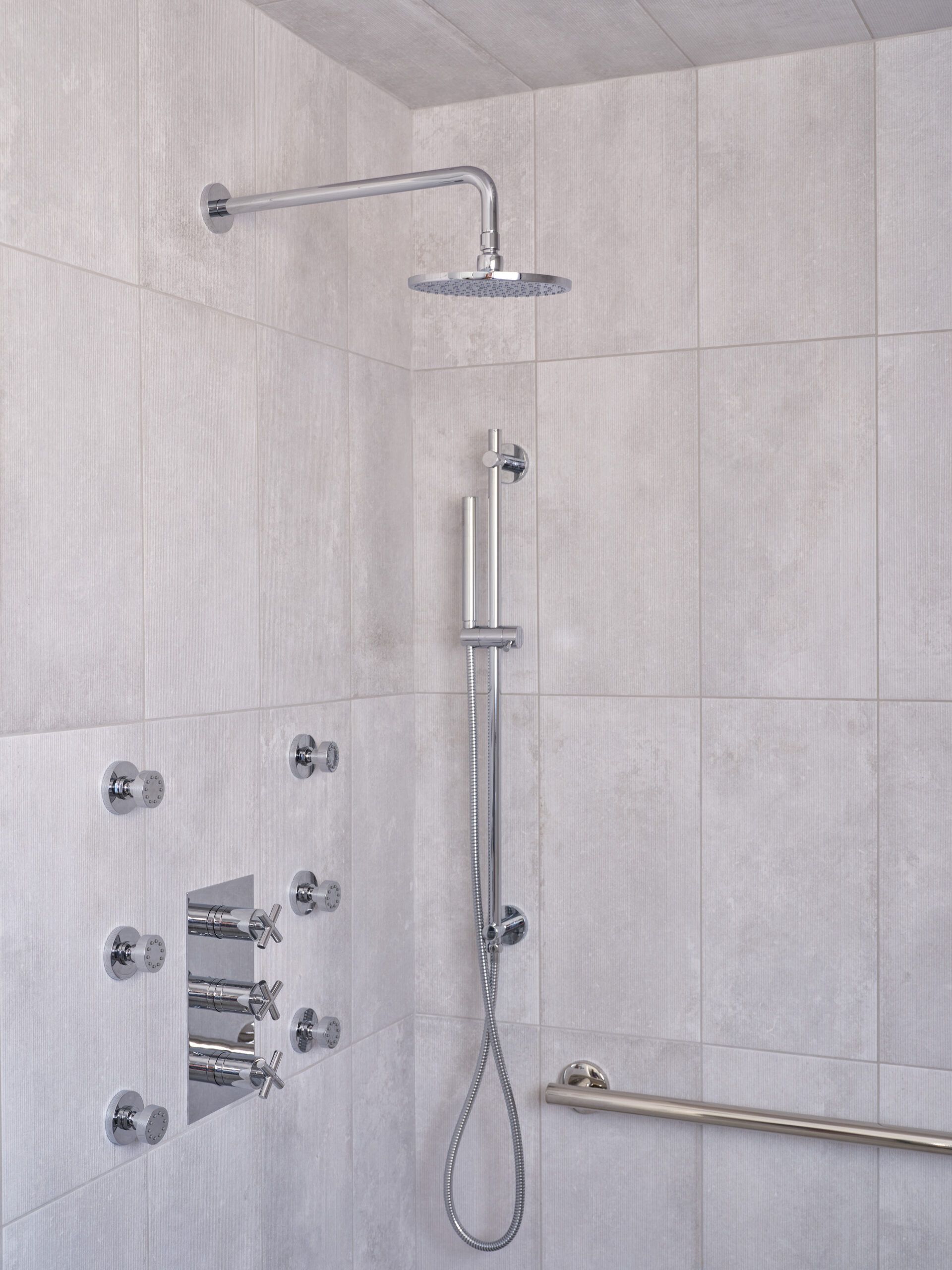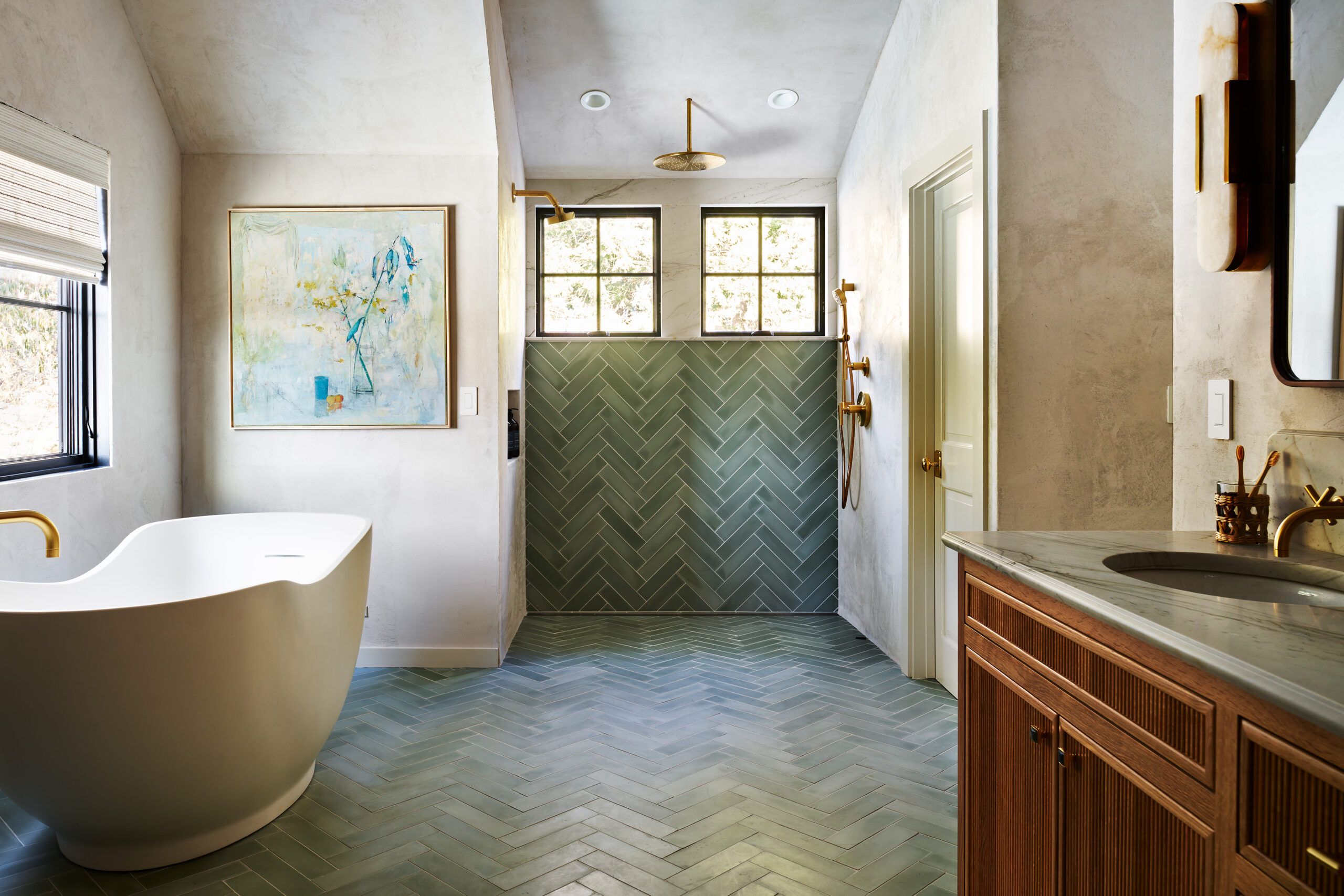From compact corner showers to luxurious walk-in designs, there are bathroom shower solutions for every space and budget. Whether you’re planning a full bathroom renovation or adding a shower from scratch, understanding the various shower types, configurations, and features will help you create a space that meets your lifestyle needs and aesthetic preferences.
Start With Stall Configurations for Bathroom Showers

The first step in choosing a shower is deciding on the stall configuration. This choice will largely depend on your bathroom’s size and layout, as well as your household’s bathing needs. The International Building Code specifies that a shower must be at least 30 inches wide by 30 inches deep. With that designation, here are the main types of shower stall configurations to consider.
Tub-Shower Combo
A tub-shower combo combines a bathtub with a shower and is a popular choice for those with limited space or families with young children.
Basics: Standard sizes for tub-shower combos are 36 inches by 48 inches or 36 inches by 60 inches. Users must be able to step over the tub wall safely. For those with mobility issues, walk-in tubs with shower capabilities are available.
Best for: Smaller bathrooms, homes with only one bathroom, or families that need a tub for bathing young children
Benefits: A tub-shower combo has a space-efficient design, adds resale value by providing both a shower and tub in the same space, and offers versatility for different bathing preferences.
Walk-in Shower

Walk-in showers are popular for their sleek appearance and accessibility. These showers typically have three walls and an open entry, creating an airy, spacious feel in the bathroom.
Basics: Standard sizes for walk-in showers start at 36 inches by 42 inches, with larger options available. You can design them with a minimal curb or have them be completely curbless for easy access.
Best for: Larger bathrooms, those who prefer an open and modern look, and individuals with mobility concerns
Benefits: Walk-in showers create a sense of spaciousness, are easier to clean than traditional enclosed showers, and can accommodate those in a wheelchair.
Corner Shower
Corner showers are an excellent solution for maximizing space in smaller bathrooms. These showers fit snugly into a bathroom corner and come in various shapes, including square, rectangular, and neo-angle.
Basics: The most common size for a corner shower is 36 inches by 36 inches, though smaller and larger options are available.
Best for: Bathrooms with limited space, powder room conversions, or as an additional shower in a home
Benefits: A corner shower has a space-saving design, comes in versatile shape options to suit different decor styles, and adds value by creating an additional full bathroom in the home.
Prefabricated Shower
Prefab showers are a popular choice for those looking for a quick and cost-effective shower solution. These showers come as a complete unit or in several pieces that you can easily assemble.
Basics: Prefab showers typically range from 32 inches by 32 inches to 60 inches by 70 inches, offering options for various bathroom sizes.
Best for: DIY installations, rental properties, or secondary bathrooms where budget is a primary concern
Benefits: Prefab showers are easy to install, are more affordable compared to custom-built showers, and require minimal maintenance due to their seamless construction.
Select a Shower System

A shower system refers to the plumbing components that deliver water. Most important are the valves that power the spray and the controls for water volume and temperature. Taps, faucets, drains, and showerheads are also a part of the system.
Here are the main types of shower systems to consider:
Digital
Gaining popularity in smart homes, digital controls let you plan, customize, and adjust your preferred shower experience via a wall-mounted control panel. Not only can you preset precise desired temperatures for various household members, but you can also establish an exact shower time and receive an alert to keep you on schedule. A Wi-Fi-enabled app allows you to start your shower remotely and signal you when the temperature is just right.
Electric
Rather than relying on the home’s water heater, this type of system employs a separate electrical device built into the shower to heat water on demand prior to dispensing it. Electric systems often have memory settings that can save several preferred temperatures and increase water pressure. However, electric systems are fairly uncommon in the United States.
Pressure-Balanced
This popular standard system, also known as a manual mixer, features a single valve to control both water volume and temperature. The user turns one handle or knob to deliver the spray. While the temperature is adjustable, the force of the water is either on or off. A pressure-balanced valve tends to be the most affordable choice and the easiest for DIY installation.
Steam
For wellness benefits and spa-like luxury, consider a shower enclosure with added steam capability. A small generator, usually tucked into a nearby cabinet, heats water and then pumps in steam through ports in the floor. Steam shower enclosures must be totally watertight and typically have tiles all around the structure, except for the glass door opening. The enclosure’s ceiling should have a slight slope to direct water droplets away from users.
Thermostatic
This system offers more control because there are separate valves for water pressure and temperature. Thermostatic valves prevent accidental scalding by holding water to a precise maximum temperature, a smart safety measure for households with young kids. Additionally, users can increase or decrease the water flow without changing the temperature.
Choose Your Ideal Showerheads
While a fixed showerhead is simply a nozzle with a perforated cap attached to the wall of the enclosure, there are additional options available. Keep in mind that as part of a national water-saving initiative, the maximum flow rate the U.S. government allows for showerheads is 2.5 GPM (gallons per minute)—and in some municipalities, the flow rate may be 1.8 GPM. If you like a strong shower but your area dictates a low-flow showerhead, read product labels for terms, such as “massaging” and “powerful,” to ensure the design can deliver your preferred pressure.
Handheld
A handheld showerhead allows you to direct the water spray wherever you want it—a benefit when massaging sore muscles or rinsing shampoo, as well as bathing young children and cleaning the shower’s surfaces. This showerhead tends to have a variety of spray modes, from gentle to intense. Handhelds are usually mounted high on the wall to function like a fixed showerhead until the business end detaches from its dock.
Rainfall
Larger than standard fixed showerheads and typically mounted to the ceiling, a rainfall showerhead delivers a vertical spray designed to mimic a pleasing light rain as opposed to a regular showerhead in which the water spray flows at an angle. It’s typically round in shape with a wide diameter, ranging from eight to 14 inches. Because of the gentle pressure, the spray feels more relaxing than invigorating.
Tower
A sleek shower tower, also called a column, encompasses the valves of the system (traditionally installed behind a stall wall) and controls, but its chief appeal is its spray options. In addition to a primary overhead showerhead, it may include a handheld unit and several massaging body jets. Shower towers are fairly large, so you’d need a spacious, high-ceilinged enclosure for it to work properly, and the water pressure must be strong enough to power the multiple showerheads and jets.
Waterfall
A waterfall showerhead dispenses a broader, stronger spray than rainfall models. This type of fixture is usually modern in appearance, often rectangular in shape, and may feature mood lighting.
Additional Shower Features To Consider
To enhance your shower experience, consider the following features:
- Built-in shelving: Integrated shelves provide convenient storage for toiletries and can complement your shower’s design.
- Lighting: Consider waterproof LED options or chromotherapy lighting for a spa-like ambiance.
- Non-slip flooring: Textured tiles or specialized non-slip surfaces can improve safety in the shower.
- Shower benches: A built-in bench adds comfort and safety, especially for those with mobility issues.
- Shower doors: Choose from framed, frameless, or sliding doors to complement your bathroom’s style and functionality.
- Water-saving fixtures: Low-flow showerheads and faucet aerators can help conserve water. These options are great for environmentally conscious households and can reduce utility bills over time.

